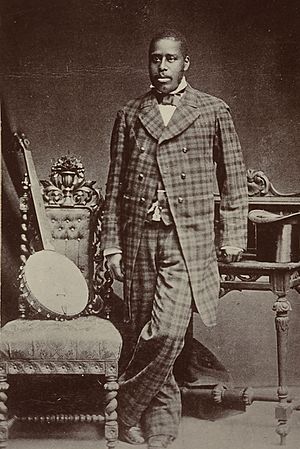Horace Weston facts for kids
Quick facts for kids
Horace Weston
|
|
|---|---|
 |
|
| Background information | |
| Born | 1825 Derby, Connecticut, U.S. |
| Died | (aged 65) Manhattan, New York City, U.S. |
| Genres | Minstrelsy |
| Occupation(s) | Musician, composer |
| Instruments | Banjo |
| Years active | 1850s–1890 |
Horace Weston (born 1825 – died 1890) was an amazing American musician. Many people thought he was one of the best banjo players ever! He was famous for his incredible skill and became a big star in minstrel shows.
Contents
Early Life and Music
Horace Weston was born in Derby, Connecticut. He was born free, meaning he was never enslaved. While some records say he was born in 1825, the exact year is a little unclear. As a child, he moved to Waterbury. His father was also a musician and taught music and dancing.
Horace left home when he was young. He learned to play many instruments, like the accordion, violin, and guitar. He also worked as a dance teacher. He traveled around New York state. After his guitar broke, he started learning the banjo. Soon, he was playing the banjo on the streets of Hartford, Connecticut.
Joining the Military
In 1861, Horace tried to join the United States Army. However, at that time, black volunteers were not allowed to join. So, he joined the U.S. Navy in Boston instead. He entertained his fellow sailors by playing his banjo. Later, he joined the 54th Massachusetts Volunteer Regiment. This was one of the first African American regiments in the U.S. Army.
Becoming a Star
Horace left the military in 1863. He then joined a group called Buckley's Serenaders in Boston. In 1867, he played with the Georgia Colored Minstrels. After that, he worked in theaters in New York City for over a year.
For the next few years, Horace played with different minstrel shows. He performed in Boston and New York. He even toured Canada! He was also a very popular banjo teacher. People knew him as a super talented player. He mostly played the banjo in a style similar to "frailing".
Performing for Royalty
Starting in 1876, Horace worked for producers Henry C. Jarrett and Henry Palmer. He played on a boat called Plymouth Rock. Then, he performed in their play, Uncle Tom's Cabin. They took the show to Europe in 1878. Horace became very successful in London.
After one show, he met the Prince of Wales. Then, he was invited to play for Queen Victoria herself! There were stories that he couldn't read the invitation. But Horace later said he found the letter and realized the date hadn't passed. He said they "patched up the matter." It's not totally clear if he performed for the Queen that time. But it was said that on a later visit in the 1880s, the Queen gave him a gold medal.
Later Career and Legacy
After returning to the U.S., Horace played with different groups. He toured the U.S. with Callender's Minstrels, going as far as Oregon. He also had a long performance in Philadelphia. Towards the end of his career, he performed with the famous Ringling Bros. and Barnum & Bailey Circus.
Horace Weston was one of the first African Americans to become a famous musician. He was a huge star in minstrel shows. People called him "The World's Greatest Banjoist." He even worked with the S. S. Stewart banjo company. They built banjos based on his designs.
He also wrote several banjo songs. Some of his pieces include "Horace Weston's Home Sweet Home" and "Horace Weston's New Schottische." When he died, many believed he was "perhaps the greatest banjoist the world has ever heard."
Final Years
In his later years, Horace suffered from rheumatism, which affected his joints. He then got dropsy, a condition that caused swelling. These illnesses led to his death at his home in Bleecker Street, New York, in 1890. He was buried at Evergreens Cemetery.

